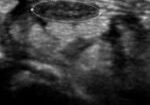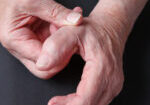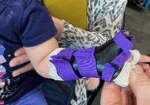Does Obesity or Smoking change the outcomes for Distal Radius Fractures
Filed under Reviews
Hall, Matthew J., Ostergaard, P., Dowlatshahi, A., Harper, C., Earp, B. Rozental, T. (2019). The Impact of Obesity and Smoking on Outcomes After Volar Plate Fixation of Distal Radius Fractures. The Journal of Hand Surgery. In Press, Corrected Proof, Available online 31 October 2019. Doi: https://doi.org/10.1016/j.jhsa.2019.08.017
The Skinny- Distal radius fractures are one of the most common fractures seen in the clinic. Few studies have focused on the effect of risk factors such as BMI or smoking on outcomes after volar plate distal radius fracture. This retrospective study examined 200 patients between 2006-2017 experiencing a BMI >30 or have smoked at least 100 cigarettes in their lifetime and had smoked within 28 days of the injury. Patients had to have undergone a volar ORIF and had at least 1 year follow-up to meet inclusion criteria.
In the Weeds- For each patient in the database radiographs were examined and Radiographic Union Scoring System (RUSS) was noted. Functional measurements were obtained through QuickDASH scores, and ROM measurements were collected.
Results: Patients with a BMI >30 reported minimally greater QuickDASH scores at 1 year follow-up. Smokers displayed delayed bone healing and reported lower QuickDASH scores at 3 months but achieved excellent functional and radiographic outcomes at the final follow-up. Neither cohort experienced significant complications or poor RUSS scores at 1 year follow-up. Obesity or smoking were not linked to any ROM deficits.
Bring it Home- This study demonstrates that neither obesity or smoking had a significant negative impact on the outcomes of patients who underwent an ORIF for distal radius fractures. Smoking appears to delay bone healing, but did not have a significant effect on QuickDASH or RUSS scores at 1 year follow-up. These results may be in part due to the exclusive method of volar plate fixation in this study, providing the wound with an envelope of soft tissue to facilitate healing (distal radius fracture repair with volar plate).
This study’s strengths include a large cohort size with longitudinal follow-up. Data analysis measures were taken to isolate the risk factors of obesity and smoking, making the results reliable for this cohort. A limitation of this study is that it relies heavily on the accuracy of patient-reported history. QuickDASH scores can be negatively influenced if the patient is experiencing other upper extremity injuries. RUSS scores were a way to obtain subjective data on the healing of the fractures, being the only scoring system available to quantify the amount of healing in distal radius fractures, despite it not being an officially validated measure.
More To Read
THE SENSITIVITY AND SPECIFICITY OF ULTRASOUND FOR THE DIAGNOSIS OF CARPAL TUNNEL SYNDROME: A META-ANALYSIS
Fowler, J. R., Gaughan J. P., & Ilyas, A.M. (2011). The sensitivity and specificity of ultrasound for the diagnosis of carpal tunnel syndrome: A meta-analysis. Clinical Orthopedics and Related Research, 469(4), 1089-1094. The Skinny –The authors sought out to determine the sensitivity and specificity of ultrasound therapy for the diagnosis of carpal tunnel syndrome using…
Read MoreChanges in ROM of the MCP after Trapeziometacarpal Arthrodesis
Rapid Review: Changes in ROM of the MCP after Trapeziometacarpal Arthrodesis Hayashi, M., Kato, H., Komatsu, M., Yamazaki, H., Uchiyama, S., & Takahashi, J. (2021). Changes in the Functional Range of Motion of the Thumb Metacarpophalangeal Joint After Trapeziometacarpal Arthrodesis for Patients With Advanced Trapeziometacarpal Osteoarthritis. The Journal of hand surgery, S0363-5023(21)00613-4. Advance online publication. https://doi.org/10.1016/j.jhsa.2021.09.018. The Skinny: Several published…
Read MoreSplinting and Stretch Protocol for Pediatric Trigger Thumb
Tan, A. C., Lam, K. S., & Lee, E. H. (2002). The Treatment Outcome of Trigger Thumb in Children. Journal of Pediatric Orthopaedics B, 11(3), 256-259. The Skinny:Pediatric trigger thumb is a “relatively uncommon” condition of unknown origins. Studies have indicated that spontaneous recovery of trigger thumb is around 25-40%, and chances increase with age.…
Read MoreWrist Fractures and Marijuana Use: What are the complications?
Title: Marijuana use and complications with healing after distal radius wrist fracture Article: Livesey, M. G., Bains, S. S., Stern, J. M., Chen, Z., Dubin, J. A., Monárrez, R., … & Ingari, J. V. (2025). Cannabis use in patients with distal radius fractures: a moment of unity?. Hand, 20(2), 263-268. The skinny The impact of tobacco use…
Read MoreSign-up to Get Updates Straight to Your Inbox!
Sign up with us and we will send you regular blog posts on everything hand therapy, notices every time we upload new videos and tutorials, along with handout, protocols, and other useful information.






